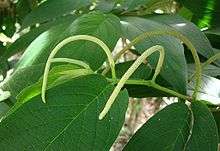Piper aduncum
| Matico | |
|---|---|
 | |
| Scientific classification | |
| Kingdom: | Plantae |
| (unranked): | Angiosperms |
| (unranked): | Magnoliids |
| Order: | Piperales |
| Family: | Piperaceae |
| Genus: | Piper |
| Species: | P. aduncum |
| Binomial name | |
| Piper aduncum L. | |
| Synonyms | |
|
Piper angustifolium Ruiz & Pav. | |
Piper aduncum, the spiked pepper, matico or higuillo de hoja menuda,[3] is a flowering plant in the family Piperaceae. Like many species in the family, the matico tree has a peppery odor.
Use
The fruits are used as a condiment and for flavoring cocoa.[4] It is sometimes used as a substitute for long pepper.
Traditional medicine
In the Amazon Rainforest, many of the native tribes use matico leaves as an antiseptic. In Peru, it was used for stopping hemorrhages and treating ulcers, and in European practice in the treatment of diseases of the genitals and urinary organs, such as those for which cubeb was often prescribed.[5]
Characteristics
Matico is a tropical, evergreen, shrubby tree that grows to the height of 6 to 7 meter (20 to 23 ft) with lance-shaped leaves that are 12 to 20 centimeter (5 to 8 in) long. It is native to Southern Mexico, the Caribbean, and much of tropical South America. It is grown in tropical Asia, Polynesia, and Melanesia and can even be found in Florida, Hawaii, and Puerto Rico. In some countries matico is considered as an invasive weed.[2] In parts of New Guinea, although matico is notorious for drying out the soil in the areas where it is invasive, the wood of this plant is nonetheless used by local residents for a myriad of uses such as for fuel and fence posts.[6]
Etymology
According to legends, the plant was discovered by a wounded Spanish soldier named Matico.[2] He learned, presumably from the local tribes, that applying the leaves to his wounds stopped bleeding, and it began to be called "Matico" or "soldier's herb". It was introduced into the profession of medicine in the United States and Europe by a Liverpool physician in 1839 as a styptic and astringent for wounds.[2]
Notes
- ↑ Barlow, Prof. Snow (2003). "Sorting Piper names". University of Melbourne. Retrieved 2007-03-29.
- 1 2 3 4 Taylor, Dr. Leslie (2006). "Technical Data Report for Matico (Piper aduncum, angustifolium)" (PDF). Raintree Nutrition, Inc. Retrieved 2007-03-29.
- ↑ "Piper aduncum". Natural Resources Conservation Service PLANTS Database. USDA. Retrieved 5 Octoboer 2015. Check date values in:
|access-date=(help) - ↑ Seidemann, Johannes (2005). World Spice Plants: Economic Usage, Botany, Taxonomy. Springer. p. 289. ISBN 3-540-22279-0.
- ↑ Remington, Joseph P. (Ed); Horatio C. Wood (1918). "The Dispensatory of the United States of America". Retrieved 2007-03-29.
- ↑ Siges, T.; A.E. Hartemink; P. Hebinck; B.J. Allen (2005). "The invasive shrub Piper aduncum and rural livelihoods in the Finschhafen area of Papua New Guinea" (PDF). Human Ecology. 33 (6): 875–893. doi:10.1007/s10745-005-8214-7. Retrieved 2007-04-16.
External links
| Wikimedia Commons has media related to Piper aduncum. |
| Wikispecies has information related to: Piper aduncum |